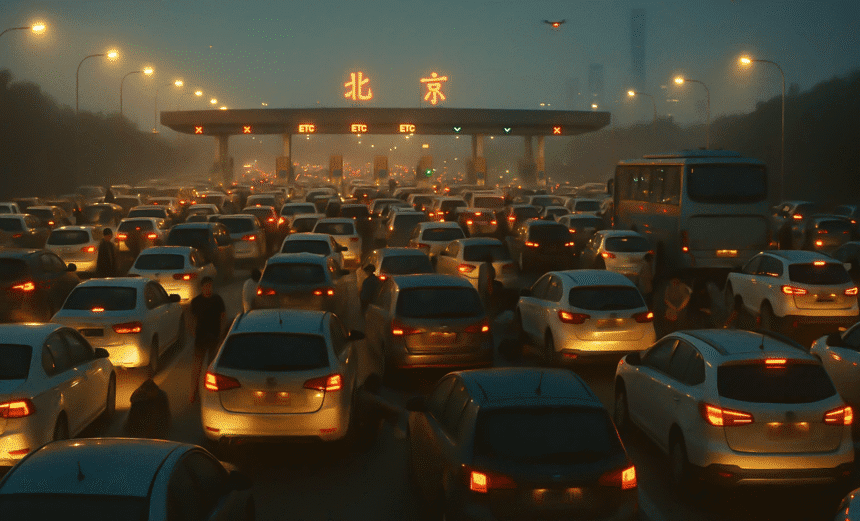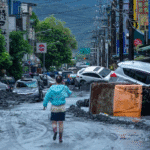Millions of Chinese travelers returning home at the end of the National Day “Golden Week” holiday found themselves trapped in massive gridlock that stretched for hundreds of kilometers, as highways leading into major cities became motionless for more than 24 hours. The Golden Week holiday, which ran from October 1 to October 7, is one of China’s most important annual travel periods, marking National Day celebrations and offering millions their only extended break of the year. This year, the Ministry of Transport reported over 850 million domestic trips, a post-pandemic record driven by pent-up travel demand and lower fuel costs.
As the seven-day holiday ended, the return rush turned highways into long chains of immobile vehicles. The worst congestion occurred along the Beijing–Hong Kong–Macau Expressway (G4), the Shanghai–Chengdu Expressway (G42), and major routes heading into Guangzhou, Shanghai, and Beijing. Satellite traffic maps showed long red ribbons of jammed vehicles stretching for over 120 kilometers near major toll gates, where travelers faced gridlock that, at times, barely moved at all.
Officials and traffic analysts pointed to several causes behind the unprecedented jam. Record-breaking traffic volume was the primary factor, with more than 72 million cars on Chinese roads on October 7 alone, a 15 percent increase from the previous year. The government’s toll-free travel policy for passenger cars during the holiday encouraged more people to drive instead of using trains or planes. However, when toll collection resumed at midnight on October 7, thousands of vehicles simultaneously converged on payment gates, creating instant choke points. Several minor accidents and vehicle breakdowns further worsened the situation, while blocked emergency lanes made it difficult for responders to reach the affected areas.
The worst of the congestion lasted for nearly 24 hours, from the evening of October 7 through late October 8. Traffic authorities in Hebei, Jiangsu, and Hunan provinces reported vehicles moving as slowly as two kilometers per hour in certain stretches. Many drivers spent the night inside their cars, unable to find rest stops or exits. “People were frustrated but surprisingly patient,” said Liang Wei, a driver who took 19 hours to cover just 300 kilometers back to Wuhan. “It felt like a slow-moving campsite. Everyone knew it would happen, but this year was much worse.”
To manage the chaos, the Ministry of Public Security deployed more than 500,000 traffic police officers nationwide. Authorities used drones to monitor road conditions and rerouted vehicles to alternative paths where possible. Emergency service stations were set up to provide fuel, food, and medical aid to stranded travelers. Local governments used radio, Weibo, and Douyin (China’s TikTok) to broadcast real-time traffic updates. By around 10 p.m. on October 8, state broadcaster CCTV reported that the gridlock had begun to ease, though some routes remained congested into the next morning.
The Ministry of Transport later announced plans to review its toll and traffic management systems, suggesting measures such as staggered toll resumption, dynamic congestion alerts, and enhanced forecasting technology to prevent similar crises in future holidays. Despite the frustrations, economists noted that the massive traffic surge reflected the country’s booming domestic tourism and consumer spending. According to the China Tourism Academy, Golden Week generated approximately ¥753 billion (US$103 billion) in tourism revenue, an increase of 12 percent from the previous year.
However, environmental experts warned of the heavy ecological cost. It is estimated that idling vehicles during the jam emitted more than 1.8 million tons of carbon dioxide. “This is a reminder of the environmental consequences of mass private car ownership,” said Chen Xiaoran, an environmental policy researcher in Beijing.
Since its introduction in 1999, Golden Week has successfully boosted domestic tourism and spending but has also exposed the limits of China’s transport infrastructure. With car ownership now exceeding 340 million nationwide, even the country’s vast highway network struggles to absorb the surge during major holidays. While high-speed rail offers a faster and more efficient alternative, many families still prefer the flexibility and affordability of driving, especially for medium-distance trips.
Experts are calling for smarter travel planning, improved infrastructure, and regional coordination to prevent annual gridlock. “China’s highways are among the busiest in the world,” said transport analyst Wang Hui. “Unless we innovate in traffic management and encourage more balanced travel times, post-holiday congestion could soon stretch for days instead of hours.”


















